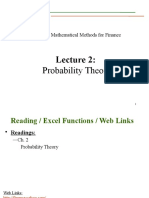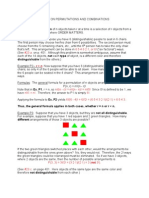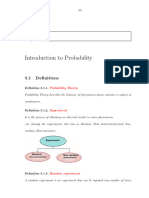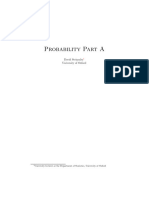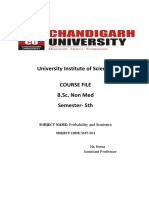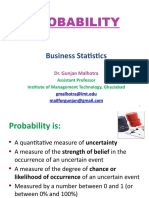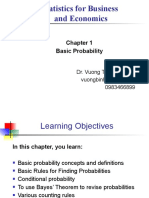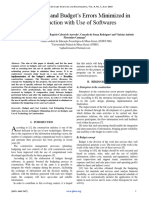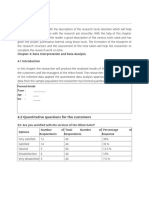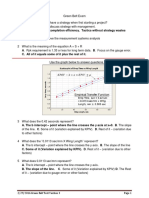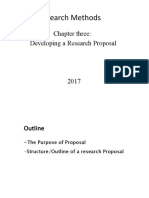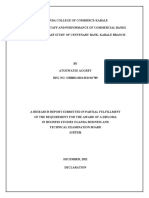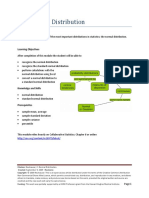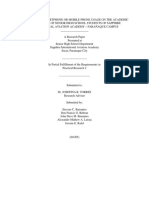Basic Probability
Concepts & Applications
Chap 2-1
�A Survey of Probability Concepts
Descriptive statistics is concerned with
summarizing data collected from past events.
For example, Whitner Autoplex.
Second facet of statistics is computing the
chance that something will occur in the future.
This facet of statistics is called statistical
inference or inferential statistics.
probability, chance, and likelihood
chap 2-2
�A Survey of Probability Concepts
Probability: A value between zero and one,
inclusive, describing the relative possibility (chance
or likelihood) an event will occur.
It can assume any number from 0 to 1.
0 probability means the event cannot happen
1 probability means event will happen surely
Probability close to 0, more improbable that event
will happen
Probability close to 1, more probable that event will
happen
chap 2-3
�Probabilities of Different Events
chap 2-4
�Important Terms
Random Experiment a process leading to an
uncertain outcome or a process that leads to the
occurrence of one and only one of several
possible observations.
A coin is thrown
A consumer is asked which of two products he
or she prefers
The daily change in an index of stock market
prices is observed
chap 2-5
�Important Terms
OUTCOME : A particular result of an
experiment.
E.g. Head comes after tossing a coin
Out of 500 students 220 wanted to purchase
Toshiba laptop
chap 2-6
�Important Terms
Sample Space - Collection of all possible
outcomes
e.g.: All six faces of a die:
e.g.: All 52 cards
a deck of
bridge cards
7
chap 2-7
�Important Terms
Event any subset of basic outcomes from the
sample space or an event is any collection of
outcomes of an experiment
Simple or Elementary Event
Outcome With 1 Characteristic
Red card from a deck of cards
Ace card from a deck of cards
chap 2-8
�Examples
Experiment: rolling a dice once
Sample space S = {1,2,3,4,5,6}
Event A = 'score < 4' = {1,2,3}
Event B = 'score is even' = {2,4,6}
Event C = 'score is 7' =
chap 2-9
�chap 2-10
�chap 2-11
�Important Terms
Joint Event
2 Events Occurring Simultaneously
A and B,
(A B):
Red, ace card from a deck of cards
Male, over age 20
�Important Terms
Compound Event
One or Another Event Occurring
D or E, (D E):
Ace or Red card from deck of cards
chap 2-13
�Important Terms
(continued)
Intersection of Events If A and B are two
events in a sample space S, then the
intersection, A B, is the set of all outcomes in
S that belong to both A and B
S
A
AB
chap 2-14
�Important Terms
(continued)
A and B are Mutually Exclusive Events if they
have no basic outcomes in common
i.e., the set A B is empty
S
A
chap 2-15
�Important Terms
(continued)
Union of Events If A and B are two events in a
sample space S, then the union, A U B, is the
set of all outcomes in S that belong to either
A or B
S
A
The entire shaded
area represents
AUB
chap 2-16
�Important Terms
(continued)
Events E1, E2, Ek are Collectively Exhaustive
events if E1 U E2 U . . . U Ek = S
i.e., the events completely cover the sample space
The Complement of an event A is the set of all
basic outcomes in the sample space that do not
belong to A. The complement is denoted A
S
A
chap 2-17
�Examples
Let the Sample Space be the collection of all
possible outcomes of rolling one die:
S = [1, 2, 3, 4, 5, 6]
Let A be the event Number rolled is even
Let B be the event Number rolled is at least 4
Then
A = [2, 4, 6]
and
B = [4, 5, 6]
chap 2-18
�Examples
(continued)
S = [1, 2, 3, 4, 5, 6]
A = [2, 4, 6]
B = [4, 5, 6]
Complements:
A [1, 3, 5]
B [1, 2, 3]
Intersections:
A B [4, 6]
Unions:
A B [5]
A B [2, 4, 5, 6]
A A [1, 2, 3, 4, 5, 6] S
chap 2-19
�Examples
(continued)
S = [1, 2, 3, 4, 5, 6]
B = [4, 5, 6]
Mutually exclusive:
A and B are not mutually exclusive
A = [2, 4, 6]
The outcomes 4 and 6 are common to both
Collectively exhaustive:
A and B are not collectively exhaustive
A U B does not contain 1 or 3
chap 2-20
�Assessing Probability
There are three approaches to assess the
probability of an uncertain event:
1. classical probability
probability of event A
NA
number of outcomes that satisfy the event A
N
total number of outcomes in the sample space
Assumes all outcomes in the sample space are equally likely to
occur
chap 2-21
�chap 2-22
�Assessing Probability
Three approaches (continued)
2. Empirical / relative frequency probability
3. subjective probability
The likelihood (probability) of a particular event happening that is
assigned by an individual based on whatever information
is available.
chap 2-23
�Example
chap 2-24
�chap 2-25
�Examples
1 One card will be randomly selected from a standard 52-card deck.
What is the probability the card will be a queen? Which approach
to probability did you use to answer this question?
2 The Center for Child Care reports on the parental status of 539
children. The parents of 333 children are married, 182 divorced,
and 24 widowed. What is the probability a particular child chosen at
random will have a parent who is divorced? Which approach did
you use?
3 What is the probability that the Dow Jones Industrial Average will
exceed 12,000 during the next 12 months? Which approach to
probability did you use to answer this question?
chap 2-26
�Exercises
1. Some people are in favor of reducing federal
taxes to increase consumer spending and
others are against it. Two persons are selected
and their opinions are recorded. List the
possible outcomes.
2. A quality control inspector selects a part to be
tested. The part is then declared acceptable,
repairable, or scrapped. Then another part is
tested. List the possible outcomes of this
experiment regarding two parts.
chap 2-27
�Example
chap 2-28
�Examples
chap 2-29
�Examples
�Probability Postulates
1. If A is any event in the sample space S, then
0 P(A) 1
2. Let A be an event in S, and let Oi denote the basic
outcomes. Then
P(A) P(Oi )
A
(the notation means that the summation is over all the basic outcomes in A)
3. P(S) = 1
chap 2-31
�Probability Rules
The Complement rule:
P(A) 1 P(A)
i.e., P(A) P(A) 1
The Addition rule:
The probability of the union of two events is
P(A B) P(A) P(B) P(A B)
chap 2-32
�Addition Rule Example
Consider a standard deck of 52 cards, with four suits:
Let event A = card is an Ace
Let event B = card is from a red suit
Find P(A or B)?
chap 2-33
�Addition Rule Example
(continued)
P(Red U Ace) = P(Red) + P(Ace) - P(Red Ace)
= 26/52 + 4/52 - 2/52 = 28/52
Type
Color
Red
Black
Total
Ace
Non-Ace
24
24
48
Total
26
26
52
Dont count
the two red
aces twice!
chap 2-34
�JOINT PROBABILITY
A probability that measures the likelihood two or
more events will happen concurrently.
GENERAL RULE OF ADDITION
P(A or B) = P(A) + P(B) - P(A and B)
Example: What is the probability that a card
chosen at random from a standard deck of
cards will be either a king or a heart?
chap 2-35
�Examples
The events A and B are mutually exclusive.
Suppose P(A) = .30 and P(B) = .20. What is the
probability of either A or B occurring? What is
the probability that neither A nor B will happen?
The events X and Yare mutually exclusive.
Suppose P(X) = .05 and P(Y) = .02. What is the
probability of either X or Y occurring? What is
the probability that neither X nor Y will happen?
chap 2-36
�Special Rule for Addition
If two events A and a are mutually exclusive,
the special rule of addition states that the
probability of one or the other events occurring
equals the sum of their probabilities.
P(A or B) = P(A) + P(B)
For three mutually exclusive events designated A,
B, and C
P(A or B or C) = P(A) + P(B) + P(C)
chap 2-37
INDEPENDENCE :The occurrence of one event
has no effect on the probability of the
occurrence of another event.
DEPENDENCE : If two events are not
independent, they are referred to as dependent
chap 2-39
CONDITIONAL PROBABILITY:
The probability of a particular event occurring,
given that another event has occurred
GENERAL RULE OF MULTIPLICATION
P(A and B) = P(A)P(BA)
SPECIAL RULE OF MULTIPLICATION
P(A and B) = P(A)P(B)
P(A and B and C) = P(A)P(B)P(C)
chap 2-40
�Examples
What is the probability of randomly selecting an
executive who is loyal to the company and who has
more than 10 years of service?
To find the probability of selecting an executive who
would remain with the company or has less than 1 year
of experience
chap 2-41
�chap 2-42
�SELF REVIEW 5-7
(a) What is the probability of selecting an
executive with more than 10 years of service?
(b) What is the probability of selecting an
executive who would not remain with the
company, given that he or she has more than
10 years of service?
(c) What is the probability of selecting an
executive with more than 10 years of service or
one who would not remain with the company?
chap 2-43
�Examples
The probability that a certain type of machine will
broke down in the first month of operation is 0.1. If
a firm has two such machines which are installed
at the same time, find the probability that, at the
end of first month, just one has broken down.
Three friends decided to enter in marathon race.
The respective probabilities that they will complete
marathon race are 0.9, 0.7 and 0.6. Find the
probability that (a) They all complete the marathon
(b) At least two complete the marathon
chap 2-44
�Arrangements-1
1- Number of ways of arranging n unlike objects
is n!
Example 1: ABCD How many arrangements can
be made?
Example 2: Suspected car,
First letter began with V or W, the digits were 4,7
and 8 and the end letters were A, C and E. How
many cars would be needed to be checked to
be sure of including the suspected car?
chap 2-45
�Arrangements-2
2- The number of ways of arranging in a line n
objects of which p are alike, is n!/p!
Example 1: Instead of ABCD of last example we
have AAAD then 24 arrangements will reduce to
4.
Example 2: In how many ways the word
statistics be arranged?
Example 3:If the letters of the word MINIMUM
are arranged in a line at random, what is the
probability that the arrangement begin with MMM
chap 2-46
�Arrangements-2
Example 4: the letters of the word
MATHEMATICS are written, one on each of the
11 separate cards and cards are laid out in a
line. (a) Calculate the number of different
arrangements of these letters. (b) Determine
the probability that vowels are all placed
together.
chap 2-47
�MULTIPLICATION FORMULA: If there are m
ways of doing one thing and n ways of doing
another thing, there are m x n ways of doing
both.
Total number of arrangements = (m)(n)
For three events m, n, and o
Total number of arrangements = (m)(n)(o)
4 Exterior style of home and 3 interior floor plan
chap 2-48
�PERMUTATION: Any arrangement of r objects
selected from a single group of n possible objects.
Multiplication formula is applied to find the number of
possible arrangements for two or more groups. The
permutation formula is applied to find the possible
number of arrangements when there is only one group of
objects. As illustrations of this type of problem:
n is the total number of objects.
r is the number of objects selected.
chap 2-49
The Betts Machine Shop, Inc., has eight screw
machines but only three spaces available in the
production area for the machines. In how many
different ways can the eight be arranged in the
three spaces available?
chap 2-50
�Counting the Possible Outcomes
When considering the number of
combinations of r objects from n objects, the
order in which they are placed is not
important.
where
n! = n(n-1)(n-2)(1)
0! = 1 by definition
chap 2-51
�Examples
Four letters are chosen from the word
RANDOMLY. Find the probability that all four
letters chosen are consonants.
N= 8
r=4 n(s)=70
Let E be the event that four consonants are
chosen. Since there are 6 consonants
N(E)= 6c4=15
P(E)=
n(E)/n(s)=15/70=3/14
chap 2-52
�The marketing department has been given the
assignment of designing color codes for the 42 different
lines of compact discs sold by Goody Records. Three
colors are to be used on each CD, but a combination of
three colors used for one CD cannot be rearranged and
used to identify a different CD. This means that if green,
yellow, and violet were used to identify one line, then
yellow, green, and violet (or any other combination of
these three colors) cannot be used to identify another
line. Would
seven colors taken three at a time be adequate to color
code the 42 lines?
chap 2-53
�In a lottery game, three numbers are randomly
selected from a tumbler of balls numbered 1
through 50.
(a) How many permutations are possible?
(b) How many combinations are possible?
Suppose that 4 people are to be randomly chosen out
of 10 people who agreed to be interviewed in a market
survey. The four people are to be assigned to four
interviewers. How many possibilities are there?
chap 2-54
�Suppose that 3 out of the 10 members of the board
of directors of a large corporation are to be
randomly selected to serve on a particular task
committee. How many possible selections are
there?
A company has four departments: manufacturing,
distribution, marketing, and management. The number of
people in each department is 55, 30, 21, and 13,
respectively. Each department is expected to send one
representative to a meeting with the company president.
How many possible sets of representatives are there?
chap 2-55
�Practice Questions
Q # 1: The sample space contains 6 red and 4 green marbles.
What is the probability that a randomly selected set of 3 will
include 1 Red & 2 Green marbles.
Ans: 36/120
Q # 2: ABC Inc. is hiring managers to till four key positions.
The candidates are five men and three women. Assuming that
every combination of men and women is equally likely to be
chosen, what is the probability that at least one woman will be
selected?
Ans: 16/35
Hint: A: at least one woman is selected Use complement law
chap 2-56
�Conditional Probability
A conditional probability is the probability of one
event, given that another event has occurred:
P(A B)
P(A | B)
P(B)
The conditional
probability of A given
that B has occurred
P(A B)
P(B | A)
P(A)
The conditional
probability of B given
that A has occurred
chap 2-57
�Conditional Probability Example
Of the cars on a used car lot, 70% have air
conditioning (AC) and 40% have a CD player
(CD). 20% of the cars have both.
What is the probability that a car has a CD player,
given that it has AC ?
i.e., we want to find P(CD | AC)
chap 2-58
�Conditional Probability Example
(continued)
Of the cars on a used car lot, 70% have air conditioning
(AC) and 40% have a CD player (CD).
20% of the cars have both.
CD
No CD
Total
AC
.2
.5
.7
No AC
.2
.1
.3
Total
.4
.6
1.0
P(CD AC) .2
P(CD | AC)
.2857
P(AC)
.7
chap 2-59
�Conditional Probability Example
(continued)
Given AC, we only consider the top row (70% of the cars). Of these,
20% have a CD player. 20% of 70% is 28.57%.
CD
No CD
Total
AC
.2
.5
.7
No AC
.2
.1
.3
Total
.4
.6
1.0
P(CD AC) .2
P(CD | AC)
.2857
P(AC)
.7
chap 2-60
�Multiplication Rule
Multiplication rule for two events A and B:
P(A B) P(A | B) P(B)
also
P(A B) P(B | A) P(A)
chap 2-61
�Multiplication Rule Example
P(Red Ace) = P(Red| Ace)P(Ace)
2
4
2
4
52 52
number of cards that are red and ace
2
total number of cards
52
Type
Color
Red
Black
Total
Ace
Non-Ace
24
24
48
Total
26
26
52
chap 2-62
�Statistical Independence
Two events are statistically independent
if and only if:
P(A B) P(A) P(B)
Events A and B are independent when the probability of one
event is not affected by the other event
If A and B are independent, then
P(A | B) P(A)
if P(B)>0
P(B | A) P(B)
if P(A)>0
chap 2-63
�Statistical Independence Example
Of the cars on a used car lot, 70% have air conditioning
(AC) and 40% have a CD player (CD).
20% of the cars have both.
CD
No CD
Total
AC
.2
.5
.7
No AC
.2
.1
.3
Total
.4
.6
1.0
Are the events AC and CD statistically independent?
chap 2-64
�Statistical Independence
Example: Television Ads
Out of a target audience of 2,000,000, ad A reaches
500,000 viewers, B reaches 300,000 viewers and both
ads reach 100,000 viewers.
500, 000
P ( A)
.25
2, 000, 000
300, 000
P( B)
.15
2, 000, 000
100, 000
P( A B)
.05
2, 000, 000
What is P(A | B)?
P( A B) .05 .3333 or 33%
P( A | B)
.30
P( B)
.15
�Independent Events
Example: Television Ads
So, P(ad A) = .25
P(ad B) = .15
P(A B) = .05
P(A | B) = .3333
Are events A and B independent?
P(A | B) = .3333 P(A) = .25
P(A)P(B)=(.25)(.15)=.0375 P(A B)=.05
�Practice Questions
Q # 1: A hamburger chain found that 75% of all customers use
mustard, 80% use ketchup, and 65% use both.
a.What is the probability that a customer will use at least one
of these? (0.90)
b. What is the probability that a ketchup user uses mustard?
(0.8125)
Q # 2: The probability of A is 0.70 and the probability of B is
0.80 and the probability of both is 0.50. What is the conditional
probability of A given B? Are A and B statistically independent?
�Practice Questions
Q # 3: The accompanying table shows proportions of adults
categorized to whether they are readers or non-readers of
newspapers and whether or not they voted in the last election.
Voted
Readers
Non-readers
Yes
0.63
0.13
No
0.14
0.10
What is the probability that a randomly chosen adult from this
population who did not read newspaper did not vote?
(0.4348)
�chap 2-69
�chap 2-70
